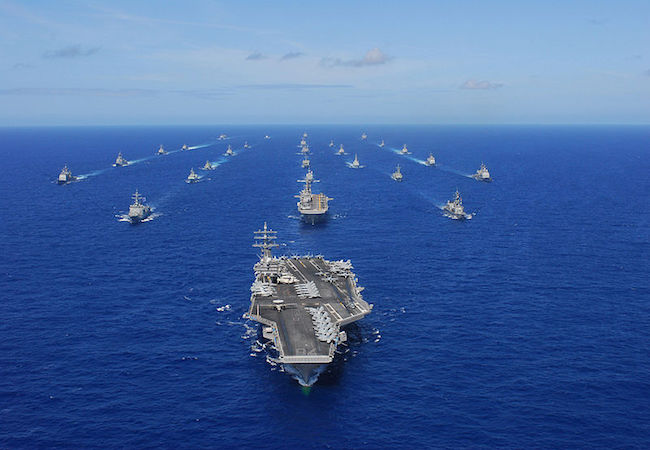
By Collins Chong Yew Keat
The ASEAN Defense Ministers’ Meeting Plus (ADMM-Plus), hosted by Cambodia, reflected yet again the growing fears on the spiralling ramifications of the tensions in South China Sea, where affected regional players have limited options to gain support or deterrence. By relying on formal diplomatic and dialogue platforms including ADMM+ as a mechanism to reduce risks and tensions and to build more confidence building measures, it presents as the only resort of official expression of a state’s reservations and fears that will garner greater regional collective responses in a way that will not risk inciting the wrath of bigger powers, especially Beijing.
Defense chiefs from the region and beyond called for respecting international rules to prevent maritime clashes in a joint declaration, signalling a common intent yet growing fears of growing direct interventionist approach that will spark greater chain implications.
U.S. Vice President Kamala Harris’ visit to the Philippines and the highlight tour to the island that faces the disputed South China Sea, together with the consistent message by US Defense Secretary Lloyd Austin in the ADMM+ Meeting,serve as another strategic manoeuvre by Washington to send an unequivocal message to Beijing that there is no letting down on America’s intent to uphold international law and regional order. Despite the risks and tensions regarding Taiwan, the region and the South China Sea in particular, remain crucial for both Beijing and Washington for different purposes. Harris reiterated the unyielding stance of the US to continue standing up for respect for sovereignty and territorial integrity, unimpeded lawful commerce and the freedom of navigation and overflight in the South China Sea, and throughout the Indo-Pacific, as part of her main message throughout the visit.
Greater clarity is given that any potential attack on the Philippines Armed Forces would invoke the U.S. mutual defense commitments, underlining Washington’s commitment to secure greater pivot and alignment from Manila and Marcos. It also serves as a message not only to Manila but to the region as a whole, including the Pacific Island states, that the US should not be seen as a distant force and will always be committed to maintain greater consistent presence in the Indo Pacific despite distractions in Ukraine. In allaying the fears and mistrusts by growing number of players in the region on Washington’s reliability and commitment to the region’s realistic needs, the coordinated series of measures of projection of influence and support are meant to shore up regional buy-in.
Although being seen as too little too late in its efforts to match Beijing’s deeper hold of the region, Washington has the edge of capitalising on the fear factor of regional players in the ultimate future quest for security, assurances of survival and regional peace in superseding the short term gains of capital and economic advantage. While most regional players see China as the inevitable next door giant that will dictate regional tempo of fear and influence, they slowly see the similar inevitability of America’s long term commitment and presence here that will negate any lost hope or tied hands by regional states in their foreign policy submission to the dictates of Beijing.
Harris again stood firm on the call to respect the tribunal decision in 2016 on the South China Sea dispute, which she reiterated remains legally binding. In doing so, the West would have the upper hand in both moral and normative standing in adhering to, and enforcing the universally accepted international law and norms. This would remain the pinnacle of the moral obligation for the US to ensure a rules based order in giving the value based legitimacy that reinforces its actions and measures in ensuring freedom of navigation and adherence to the rules. While Chinese Foreign Minister Wang Yi mentioned during the East Asia Summit in Cambodia that “the biggest risk to peace and stability in the South China Sea is precisely the inappropriate intervention and frequent interference by major countries outside the region”, obviously referring to the US, the narrative would slowly be engulfed by a backfiring ramifications of the increasingly belligerent actions by Beijing, especially in the aftermath of the show of force near Taiwan in response to Pelosi’s visit.
Accepting the fact that the region will not be freed from both Beijing and Washington’s heightened intent to scramble for dominance, the only pursuit rests in getting the powers to adhere to established rules and norms and in reducing miscalculations. By reaffirming the importance of freedom of navigation and overflight in the joint declaration, both with the Taiwan Strait and the South China Sea in mind, it gives different interpretations and perspectives to different players. To the region and the West, it reinforces the conventional and resolute pursuit of a rules based approach and in ensuring that other players play by the same rules, both for conflict prevention and for stability in crucial trade routes.
To Beijing, it would have its own interpretation on upholding its own rights for freedom of movement and activities, especially military in nature, in the South China Sea. The continuing militarisation of the sea and the expanded second front support in the Ream base in Cambodia, projected Beijing’s acceptance of the fact that Washington’s countermeasure approaches through the Freedom of Navigation operations and strategic security tie ups with key players including AUKUS will be the mainstream dependence by the US and the West in challenging its South China Sea ambitions. To Beijing, if the Germans could fly halfway around the world in their Eurofighter jets to this region to show a renewed intent and agenda for increased presence, and the French and the Brits’ continuous power projection activities here with China in mind, then the Chinese would have the full rights to operate here and fully flex its muscles, at least within the allowed sphere for now.
Washington understood the real regional fear, but was also wary of its own ineffective and unrelatable broad call and urgency for the need to uphold democracy and the virtues of ethics and values in human rights which will be unappealing for the largely semi-democratic nature of most players in the region. They wanted greater market liberalisation in the US and increased capital support with real substance, unlike IPEF’s high moral ground approach. Despite this, the region still yearn for Washington’s deterrence power, and would have no qualms in joining IPEF as a show of commitment and desire to continue drawing the sustained presence of the Americans in the region, albeit not in a form of a direct confrontational approach in military power projection which they fear would further instigate Beijing.
Washington’s interests in the South China Sea, where an estimated $3-trillion-worth of trade passes annually, would be framed not entirely from the lense of securing its own pursuit of containing China or to uphold its democratic ideals and rules based adherence alone. It will involve the bigger agenda of salvaging the dire state of stability and rules based agreement on the nature of conflict resolution and dispute management. The stakes are made higher to include the stability of the region, and in ensuring the ultimate survival of states against the onslaught of the intent of Beijing to cement a perpetual regional hegemonic stature.
By framing this cause as not one that is rooted in Washington’s perceived agenda of containing Beijing alone, a collective framework of common fear and a common adversary is moulded in gaining broader influence and pushback against unlawful and coercive behaviours of Beijing. The deterrence measures underlined in the Treaty of Amity and Cooperation (TAC) are losing their realistic appeal, if the trend of ignoring rules and norms is tolerated and seeing the lack strong responses With declining impact of deterrence measures, including dwindling effectiveness of confidence building measures and a wide array of dialogue building processes in trying to lessen risks of conflicts and preventing spiralling tensions, the question of a full blown conflict stemming from the inevitability of Thucydides’ trapping would be a matter of when and where.
For now, it is safe to say that the question of when remains the million dollar question, with most analysts pointing to the timeframe of within the timeline of this decade. For the triggering flashpoint, Taiwan would remain the highest risk for the first trigger, with the South China Sea being the crucial second front in serving the agenda of both Beijing and the Washington led West. For the purpose of Taiwan, the South China Sea will remain indispensable.
Collins Chong Yew Keat has been serving in University of Malaya for more than 9 years. His areas of focus include strategic and security studies, America’s foreign policy and power projection, regional conflicts and power parity analysis and has published various publications on numerous platforms including books and chapter articles. He is also a regular contributor in providing op-eds and analytical articles for both the local and international media on various contemporary global issues and regional affairs since 2007.




